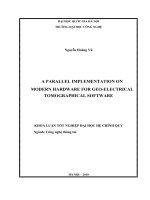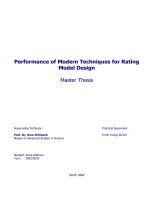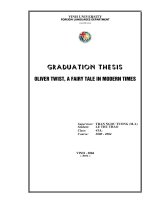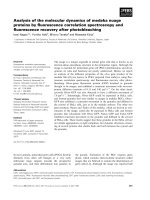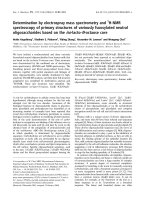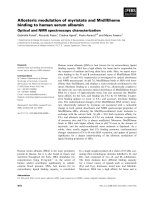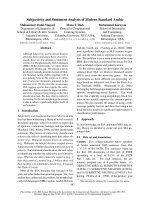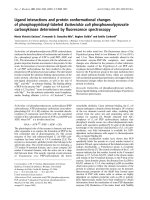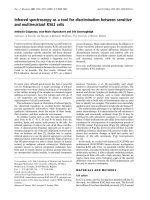Modern spectroscopy
Bạn đang xem bản rút gọn của tài liệu. Xem và tải ngay bản đầy đủ của tài liệu tại đây (2.54 MB, 483 trang )
MODERN
SPECTROSCOPY
Fourth Edition
MODERN
SPECTROSCOPY
Fourth Edition
J. Michael Hollas
University of Reading
Copyright # 1987, 1992, 1996, 2004 by John Wiley & Sons Ltd, The Atrium, Southern Gate,
Chichester, West Sussex PO19 8SQ, England
Telephone (þ44) 1243 779777
Email (for orders and customer service enquiries):
Visit our Home Page on www.wileyeurope.com or www.wiley.com
All rights reserved. No part of this publication may be reproduced, stored in a retrieval
system or transmitted in any form or by any means, electronic, mechanical, photocopying,
recording, scanning or otherwise, except under the terms of the Copyright, Designs and
Patents Act 1988 or under the terms of a licence issued by the Copyright Licensing Agency
Ltd, 90 Tottenham Court Road, London W1T 4LP, UK, without the permission in writing of
the Publisher. Requests to the Publisher should be addressed to the Permissions Department,
John Wiley & Sons Ltd, The Atrium, Southern Gate, Chichester, West Sussex PO19 8SQ,
England, or emailed to , or faxed to (þ44) 1243 770620.
This publication is designed to provide accurate and authoritative information in regard to
the subject matter covered. It is sold on the understanding that the Publisher is not engaged
in rendering professional services. If professional advice or other expert assistance is
required, the services of a competent professional should be sought.
Other Wiley Editorial Offices
John Wiley & Sons, Inc., 111 River Street, Hoboken, NJ 07030, USA
Jossey-Bass, 989 Market Street, San Francisco, CA 94103-1741, USA
Wiley-VCH Verlag GmbH, Boschstr. 12, D-69469 Weinheim, Germany
John Wiley & Sons Australia Ltd, 33 Park Road, Milton, Queensland 4064, Australia
John Wiley & Sons (Asia) Pte Ltd, 2 Clementi Loop #02-01, Jin Xing Distripark, Singapore
129809
John Wiley & Sons Canada Ltd, 22 Worcester Road, Etobicoke, Ontario, Canada M9W 1L1
Wiley also publishes its books in a variety of electronic formats. Some content that appears
in print may not be available in electronic books.
British Library Cataloguing in Publication Data
A catalogue record for this book is available from the British Library
ISBN 0 470 84415 9 (cloth)
ISBN 0 470 84416 7 (paper)
Typeset in 10.5=12.5pt Times by Techset Composition Limited, Salisbury, UK
Printed and bound in Great Britain by Anthony Rowe Ltd, Chippenham, Wilts
This book is printed on acid-free paper responsibly manufactured from sustainable forestry
in which at least two trees are planted for each one used for paper production.
Contents
Preface to first edition
xiii
Preface to second edition
xv
Preface to third edition
xvii
Preface to fourth edition
xix
Units, dimensions and conventions
xxi
Fundamental constants
xxiii
Useful conversion factors
xxv
1 Some important results in quantum mechanics
1
1.1 Spectroscopy and quantum mechanics 1
1.2 The evolution of quantum theory 2
1.3 The Schro¨dinger equation and some of its solutions 8
1.3.1 The Schro¨dinger equation
9
1.3.2 The hydrogen atom
11
1.3.3 Electron spin and nuclear spin angular momentum
17
1.3.4 The Born–Oppenheimer approximation
19
1.3.5 The rigid rotor
21
1.3.6 The harmonic oscillator
23
Exercises 25
Bibliography 26
2 Electromagnetic radiation and its interaction with atoms
and molecules
27
2.1 Electromagnetic radiation 27
2.2 Absorption and emission of radiation 27
2.3 Line width 34
2.3.1 Natural line broadening
34
2.3.2 Doppler broadening
35
2.3.3 Pressure broadening
36
2.3.4 Power, or saturation, broadening
36
2.3.5 Removal of line broadening
37
2.3.5.1 Effusive atomic or molecular beams
37
2.3.5.2 Lamb dip spectroscopy
37
v
Exercises 38
Bibliography 39
3 General features of experimental methods
41
3.1 The electromagnetic spectrum 41
3.2 General components of an absorption experiment 42
3.3 Dispersing elements 43
3.3.1 Prisms
43
3.3.2 Diffraction gratings
45
3.3.3 Fourier transformation and interferometers
48
3.3.3.1 Radiofrequency radiation
49
3.3.3.2 Infrared, visible and ultraviolet radiation
55
3.4 Components of absorption experiments in various regions of the spectrum 59
3.4.1 Microwave and millimetre wave
59
3.4.2 Far-infrared
61
3.4.3 Near-infrared and mid-infrared
62
3.4.4 Visible and near-ultraviolet
62
3.4.5 Vacuum- or far-ultraviolet
63
3.5 Other experimental techniques 64
3.5.1 Attenuated total reflectance spectroscopy and
reflection–absorption infrared spectroscopy
64
3.5.2 Atomic absorption spectroscopy
64
3.5.3 Inductively coupled plasma atomic emission spectroscopy
66
3.5.4 Flash photolysis
67
3.6 Typical recording spectrophotometers for the near-infrared, mid-infrared,
visible and near-ultraviolet regions 68
Exercise 70
Bibliography 70
4 Molecular symmetry
73
4.1 Elements of symmetry 73
4.1.1 n-Fold axis of symmetry, C
n
74
4.1.2 Plane of symmetry, s
75
4.1.3 Centre of inversion, i
76
4.1.4 n-Fold rotation–reflection axis of symmetry, S
n
76
4.1.5 The identity element of symmetry, I (or E)
77
4.1.6 Generation of elements
77
4.1.7 Symmetry conditions for molecular chirality
78
4.2 Point groups 81
4.2.1 C
n
point groups
82
4.2.2 S
n
point groups
83
4.2.3 C
nv
point groups
83
4.2.4 D
n
point groups
83
4.2.5 C
nh
point groups
84
4.2.6 D
nd
point groups
84
4.2.7 D
nh
point groups
84
vi
CONTENTS
4.2.8 T
d
point group
85
4.2.9 O
h
point group
85
4.2.10 K
h
point group
86
4.2.11 I
h
point group
86
4.2.12 Other point groups
87
4.3 Point group character tables 87
4.3.1 C
2v
character table
87
4.3.2 C
3v
character table
92
4.3.3 C
1v
character table
96
4.3.4 I
h
character table
97
4.4 Symmetry and dipole moments 97
Exercises 102
Bibliography 102
5 Rotational spectroscopy
103
5.1 Linear, symmetric rotor, spherical rotor and asymmetric rotor molecules 103
5.2 Rotational infrared, millimetre wave and microwave spectra 105
5.2.1 Diatomic and linear polyatomic molecules
105
5.2.1.1 Transition frequencies or wavenumbers
105
5.2.1.2 Intensities
110
5.2.1.3 Centrifugal distortion
111
5.2.1.4 Diatomic molecules in excited vibrational states
112
5.2.2 Symmetric rotor molecules
113
5.2.3 Stark effect in diatomic, linear and symmetric rotor molecules
115
5.2.4 Asymmetric rotor molecules
116
5.2.5 Spherical rotor molecules
117
5.2.6 Interstellar molecules detected by their radiofrequency, microwave
or millimetre wave spectra
119
5.3 Rotational Raman spectroscopy 122
5.3.1 Experimental methods
122
5.3.2 Theory of rotational Raman scattering
124
5.3.3 Rotational Raman spectra of diatomic and linear polyatomic
molecules
126
5.3.4 Nuclear spin statistical weights
128
5.3.5 Rotational Raman spectra of symmetric and asymmetric rotor
molecules
131
5.4 Structure determination from rotational constants 131
Exercises 134
Bibliography 135
6 Vibrational spectroscopy
137
6.1 Diatomic molecules 137
6.1.1 Infrared spectra
138
6.1.2 Raman spectra
140
6.1.3 Anharmonicity
142
6.1.3.1 Electrical anharmonicity
142
6.1.3.2 Mechanical anharmonicity
142
CONTENTS
vii
6.1.4 Vibration–rotation spectroscopy
147
6.1.4.1 Infrared spectra
147
6.1.4.2 Raman spectra
151
6.2 Polyatomic molecules 154
6.2.1 Group vibrations
154
6.2.2 Number of normal vibrations of each symmetry species
162
6.2.2.1 Non-degenerate vibrations
163
6.2.2.2 Degenerate vibrations
165
6.2.3 Vibrational selection rules
166
6.2.3.1 Infrared spectra
166
6.2.3.2 Raman spectra
172
6.2.4 Vibration–rotation spectroscopy
173
6.2.4.1 Infrared spectra of linear molecules
174
6.2.4.2 Infrared spectra of symmetric rotors
178
6.2.4.3 Infrared spectra of spherical rotors
180
6.2.4.4 Infrared spectra of asymmetric rotors
181
6.2.5 Anharmonicity
184
6.2.5.1 Potential energy surfaces
184
6.2.5.2 Vibrational term values
186
6.2.5.3 Local mode treatment of vibrations
187
6.2.5.4 Vibrational potential functions with more than one minimum
188
6.2.5.4(a) Inversion vibrations
189
6.2.5.4(b) Ring-puckering vibrations
191
6.2.5.4(c) Torsional vibrations
192
Exercises 195
Bibliography 196
7 Electronic spectroscopy
199
7.1 Atomic spectroscopy 199
7.1.1 The periodic table
199
7.1.2 Vector representation of momenta and vector coupling approximations
201
7.1.2.1 Angular momenta and magnetic moments
201
7.1.2.2 Coupling of angular momenta
205
7.1.2.3 Russell–Saunders coupling approximation
206
7.1.2.3(a) Non-equivalent electrons
206
7.1.2.3(b) Equivalent electrons
210
7.1.3 Spectra of alkali metal atoms
213
7.1.4 Spectrum of the hydrogen atom
216
7.1.5 Spectra of helium and the alkaline earth metal atoms
219
7.1.6 Spectra of other polyelectronic atoms
222
7.2 Electronic spectroscopy of diatomic molecules 225
7.2.1 Molecular orbitals
225
7.2.1.1 Homonuclear diatomic molecules
225
7.2.1.2 Heteronuclear diatomic molecules
232
7.2.2 Classification of electronic states
233
7.2.3 Electronic selection rules
236
7.2.4 Derivation of states arising from configurations
237
7.2.5 Vibrational coarse structure
240
7.2.5.1 Potential energy curves in excited electronic states
240
7.2.5.2 Progressions and sequences
242
viii
CONTENTS
7.2.5.3 The Franck–Condon principle
246
7.2.5.4 Deslandres tables
250
7.2.5.5 Dissociation energies
250
7.2.5.6 Repulsive states and continuous spectra
253
7.2.6 Rotational fine structure
254
7.2.6.1
1
S 7
1
S electronic and vibronic transitions
254
7.2.6.2
1
P 7
1
S electronic and vibronic transitions
257
7.3 Electronic spectroscopy of polyatomic molecules 260
7.3.1 Molecular orbitals and electronic states
260
7.3.1.1 AH
2
molecules
261
7.3.1.1(a) ff HAH¼ 180
261
7.3.1.1(b) ff HAH¼ 90
263
7.3.1.2 Formaldehyde (H
2
CO)
265
7.3.1.3 Benzene
267
7.3.1.4 Crystal field and ligand field molecular orbitals
270
7.3.1.4(a) Crystal field theory
271
7.3.1.4(b) Ligand field theory
273
7.3.1.4(c) Electronic transitions
275
7.3.2 Electronic and vibronic selection rules
275
7.3.3 Chromophores
278
7.3.4 Vibrational coarse structure
278
7.3.4.1 Sequences
278
7.3.4.2 Progressions
279
7.3.4.2(a) Totally symmetric vibrations
279
7.3.4.2(b) Non-totally symmetric vibrations
279
7.3.5 Rotational fine structure
283
7.3.6 Diffuse spectra
284
Exercises 287
Bibliography 288
8 Photoelectron and related spectroscopies
289
8.1 Photoelectron spectroscopy 289
8.1.1 Experimental methods
291
8.1.1.1 Sources of monochromatic ionizing radiation
291
8.1.1.2 Electron velocity analysers
294
8.1.1.3 Electron detectors
294
8.1.1.4 Resolution
294
8.1.2 Ionization processes and Koopmans’ theorem
295
8.1.3 Photoelectron spectra and their interpretation
297
8.1.3.1 Ultraviolet photoelectron spectra of atoms
297
8.1.3.2 Ultraviolet photoelectron spectra of molecules
298
8.1.3.2(a) Hydrogen
298
8.1.3.2(b) Nitrogen
300
8.1.3.2(c) Hydrogen bromide
302
8.1.3.2(d) Water
305
8.1.3.2(e) Benzene
305
8.1.3.3 X-ray photoelectron spectra of gases
307
8.1.3.4 X-ray photoelectron spectra of solids
313
8.2 Auger electron and X-ray fluorescence spectroscopy 315
8.2.1 Auger electron spectroscopy
317
8.2.1.1 Experimental method
317
CONTENTS
ix
8.2.1.2 Processes in Auger electron ejection
318
8.2.1.3 Examples of Auger electron spectra
319
8.2.2 X-ray fluorescence spectroscopy
322
8.2.2.1 Experimental method
322
8.2.2.2 Processes in X-ray fluorescence
324
8.2.2.3 Examples of X-ray fluorescence spectra
325
8.3 Extended X-ray absorption fine structure 327
Exercises 334
Bibliography 335
9 Lasers and laser spectroscopy
337
9.1 General discussion of lasers 337
9.1.1 General features and properties
337
9.1.2 Methods of obtaining population inversion
340
9.1.3 Laser cavity modes
341
9.1.4 Q-switching
342
9.1.5 Mode locking
344
9.1.6 Harmonic generation
345
9.2 Examples of lasers 346
9.2.1 The ruby and alexandrite lasers
346
9.2.2 The titanium–sapphire laser
348
9.2.3 The neodymium–YAG laser
349
9.2.4 The diode or semiconductor laser
350
9.2.5 The helium–neon laser
352
9.2.6 The argon ion and krypton ion lasers
354
9.2.7 The nitrogen (N
2
) laser
355
9.2.8 The excimer and exciplex lasers
356
9.2.9 The carbon dioxide laser
358
9.2.10 The dye lasers
359
9.2.11 Laser materials in general
362
9.3 Uses of lasers in spectroscopy 362
9.3.1 Hyper Raman spectroscopy
363
9.3.2 Stimulated Raman spectroscopy
365
9.3.3 Coherent anti-Stokes Raman scattering spectroscopy
367
9.3.4 Laser Stark (or laser electron resonance) spectroscopy
368
9.3.5 Two-photon and multiphoton absorption
371
9.3.6 Multiphoton dissociation and laser separation of isotopes
374
9.3.7 Single vibronic level, or dispersed, fluorescence
377
9.3.8 Light detection and ranging (LIDAR)
379
9.3.9 Cavity ring-down spectroscopy
382
9.3.10 Femtosecond spectroscopy
387
9.3.11 Spectroscopy of molecules in supersonic jets
393
9.3.11.1 Properties of a supersonic jet
393
9.3.11.2 Fluorescence excitation spectroscopy
396
9.3.11.3 Single vibronic level, or dispersed, fluorescence
spectroscopy
400
9.3.11.4 Zero kinetic energy photoelectron spectroscopy
402
Exercises 404
Bibliography 405
x
CONTENTS
Appendix
A Character tables 407
B Symmetry species of vibrations 423
Index of Atoms and Molecules
429
Subject Index
439
CONTENTS
xi
Preface to first edition
Modern Spectroscopy has been written to fulfil a need for an up-to-date text on spectroscopy.
It is aimed primarily at a typical undergraduate audience in chemistry, chemical physics, or
physics in the United Kingdom and at undergraduate and graduate student audiences
elsewhere.
Spectroscopy covers a very wide area which has been widened further since the mid-
1960s by the development of lasers and such techniques as photoelectron spectroscopy and
other closely related spectroscopies. The importance of spectroscopy in the physical and
chemical processes going on in planets, stars, comets and the interstellar medium has
continued to grow as a result of the use of satellites and the building of radiotelescopes for
the microwave and millimetre wave regions.
In planning a book of this type I encountered three major problems. The first is that of
covering the analytical as well as the more fundamental aspects of the subject. The
importance of the applications of spectroscopy to analytical chemistry cannot be overstated,
but the use of many of the available techniques does not necessarily require a detailed
understanding of the processes involved. I have tried to refer to experimental methods and
analytical applications where relevant.
The second problem relates to the inclusion, or otherwise, of molecular symmetry
arguments. There is no avoiding the fact that an understanding of molecular symmetry
presents a hurdle (although I think it is a low one) which must be surmounted if selection
rules in vibrational and electronic spectroscopy of polyatomic molecules are to be
understood. This book surmounts the hurdle in Chapter 4, which is devoted to molecular
symmetry but which treats the subject in a non-mathematical way. For those lecturers and
students who wish to leave out this chapter much of the subsequent material can be
understood but, in some areas, in a less satisfying way.
The third problem also concerns the choice of whether to leave out certain material. In a
book of this size it is not possible to cover all branches of spectroscopy. Such decisions are
difficult ones but I have chosen not to include spin resonance spectroscopy (NMR and ESR),
nuclear quadrupole resonance spectroscopy (NQR), and Mo¨ssbauer spectroscopy. The
exclusion of these areas, which have been well covered in other texts, has been caused, I
suppose, by the inclusion, in Chapter 8, of photoelectron spectroscopy (ultraviolet and X-
ray), Auger electron spectroscopy, and extended X-ray absorption fine structure, including
applications to studies of solid surfaces, and, in Chapter 9, the theory and some examples of
lasers and some of their uses in spectroscopy. Most of the material in these two chapters will
not be found in comparable texts but is of very great importance in spectroscopy today.
xiii
My understanding of spectroscopy owes much to having been fortunate in working in and
discussing the subject with Professor I. M. Mills, Dr A. G. Robiette, Professor J. A. Pople,
Professor D. H. Whiffen, Dr J. K. G. Watson, Dr G. Herzberg, Dr A. E. Douglas, Dr D. A.
Ramsay, Professor D. P. Craig, Professor J. H. Callomon, and Professor G. W. King (in more
or less reverse historical order), and I am grateful to all of them.
When my previous book High Resolution Spectroscopy was published by Butterworths in
1982 I had it in mind to make some of the subject matter contained in it more accessible to
students at a later date. This is what I have tried to do in Modern Spectroscopy and I would
like to express my appreciation to Butterworths for allowing me to use some textual material
and, particularly, many of the figures from High Resolution Spectroscopy. New figures were
very competently drawn by Mr M. R. Barton.
Although I have not included High Resolution Spectroscopy in the bibliography of any of
the chapters it is recommended as further reading on all topics.
Mr A. R. Bacon helped greatly with the page proof reading and I would like to thank him
very much for his careful work. Finally, I would like to express my sincere thanks to Mrs A.
Gillett for making such a very good job of typing the manuscript.
J. Michael Hollas
xiv
PREFACE TO FIRST EDITION
Preface to second edition
A new edition of any book presents an opportunity which an author welcomes for several
reasons. It is a chance to respond to constructive criticisms of the previous edition which he
thinks are valid. New material can be introduced which may be useful to teachers and
students in the light of the way the subject, and the teaching of the subject, has developed in
the intervening years. Last, and certainly not least, there is an opportunity to correct any
errors which had escaped the author’s notice.
Fourier transformation techniques in spectroscopy are now quite common—the latest to
arrive on the scene is Fourier transform Raman spectroscopy. In Chapter 3 I have expanded
considerably the discussion of these techniques and included Fourier transform Raman
spectroscopy for the first time.
In teaching students about Fourier transform techniques I find it easier to introduce the
subject by using radiofrequency radiation, for which the variations of the signal with time
can be readily detected—as happens in an ordinary radio. Fourier transformation of the
radiofrequency signal, which the radio itself carries out, is quite easy to visualize without
going deeply into the mathematics. The use of a Michelson interferometer in the infrared,
visible or ultraviolet regions is necessary because of the inability of a detector to respond to
these higher frequencies, but I think the way in which it gets over this problem is rather
subtle. In this second edition I have discussed Fourier transformation, relating first to
radiofrequency and then to higher frequency radiation.
In the first edition of Modern Spectroscopy I tried to go some way towards bridging the
gulf that often seems to exist between high resolution spectroscopy and low resolution, often
analytical, spectroscopy. In this edition I have gone further by including X-ray fluorescence
spectroscopy and inductively coupled plasma atomic emission spectroscopy, both of which
are used almost entirely for analytical purposes. I think it is important that the user
understand the processes going on in any analytical spectroscopic technique that he or she
might be using.
In Chapter 4, on molecular symmetry, I have added two new sections. One of these
concerns the relationship between symmetry and chirality, which is of great importance in
synthetic organic chemistry. The other relates to the connection between the symmetry of a
molecule and whether it has a permanent dipole moment.
In the chapter on vibrational spectroscopy (Chapter 6) I have expanded the discussions of
inversion, ring-puckering and torsional vibrations, including some model potential
functions. These types of vibration are very important in the determination of molecular
structure.
xv
The development of lasers has continued in the past few years and I have included
discussions of two more in this edition. These are the alexandrite and titanium–sapphire
lasers. Both are solid state and, unusually, tunable over quite wide wavelength ranges. The
titanium–sapphire laser is probably the most promising for general use because of its wider
range of tunability and the fact that it can be operated in a CW or pulsed mode.
Laser spectroscopy is such a wide subject, with many ingenious experiments using one or
two CW or pulsed lasers to study atomic or molecular structure or dynamics, that it is
difficult to do justice to it at the level at which Modern Spectroscopy is aimed. In this edition
I have expanded the section on supersonic jet spectroscopy, which is an extremely important
and wide-ranging field.
I would like to thank Professor I. M. Mills for the material he provided for Figure 3.14(b)
and Figure 3.16 and Dr P. Hollins for help in the production of Figures 3.7(a), 3.8(a), 3.9(a)
and 3.10(a). The spectrum in Figure 9.36 will be published in a paper by Dr J. M. Hollas and
Dr P. F. Taday.
J. Michael Hollas
xvi
PREFACE TO SECOND EDITION
Preface to third edition
One of the more obvious changes from the second edition which Modern Spectroscopy has
undergone concerns the page size. The consequent new format of the pages is much less
crowded and more user friendly.
Much of the additional material is taken up by what I have called ‘Worked examples’.
These are sample problems, which are mostly calculations, with answers given in some
detail. There are seventeen of them scattered throughout the book in positions in the text
appropriate to the theory which is required. I believe that these will be very useful in
demonstrating to the reader how problems should be tackled. In the calculations, I have paid
particular attention to the number of significant figures retained and to the correct use of
units. I have stressed the importance of putting in the units in a calculation. In a typical
example, for the calculation of the rotational constant B for a diatomic molecule from the
equation
B ¼
h
8p
2
cmr
2
where m ¼
m
1
m
2
m
1
þ m
2
it is an invaluable help in getting the correct answer to check the units with which m has been
calculated and then to put the units of all quantities involved into the equation for B.
Molecules with icosahedral symmetry are not new but the discovery of the newest of
them, C
60
or buckminsterfullerene, has had such a profound effect on chemistry in recent
years that I thought it useful to include a discussion of the icosahedral point group to which
C
60
belongs.
Use of the supersonic jet in many branches of spectroscopy continues to increase. One
technique which has made a considerable impact in recent years is that of zero kinetic
energy photoelectron (ZEKE-PE) spectroscopy. Because of its increasing importance and
the fact that it relates closely to ultraviolet photoelectron spectroscopy (UPS), which is
described at length in earlier editions, I have included the new technique in Chapter 9.
Charge coupled device (CCD) detectors are being used increasingly in the visible and
ultraviolet regions. At present these are very expensive but I have anticipated their increasing
importance by including a brief description in Chapter 3.
There are some quite simple symmetry rules for dividing the total number of vibrations of
a polyatomic molecule into symmetry classes. The principles behind these, and the rules
themselves, have been added to Chapter 4.
xvii
I would like to thank Professor B. van der Veken for the improved FTIR spectrum in
Figure 6.8.
J. Michael Hollas
xviii
PREFACE TO THIRD EDITION
Preface to fourth edition
Spectroscopy occupies a very special position in chemistry, physics and in science in
general. It is capable of providing accurate answers to some of the most searching questions,
particularly those concerning atomic and molecular structure. For small molecules, it can
provide accurate values of bond lengths and bond angles. For larger molecules, details of
conformation can be obtained. Is a molecule planar? If it is non-planar, what is the energy
barrier to planarity? Does a methyl group attached to a benzene ring take up the eclipsed or
staggered position? Is a cis or trans conformation more stable? Spectroscopy provides
techniques that are vital in chemical analysis and in the investigation of the composition of
planets, comets, stars and the interstellar medium.
At the research level, spectroscopy continues to flourish and is continually developing
with occasional quantum leaps. For example, such a leap resulted from the development of
lasers. Not all leaps provide suitable material for inclusion in an undergraduate text such as
this. However, even in the relatively short period of seven years since the third edition, there
have been either new developments or consolidation of rather less recent ones, which are not
only of the greatest importance but which can (I hope!) be communicated at this level.
New to the fourth edition are the topics of laser detection and ranging (LIDAR), cavity
ring-down spectroscopy, femtosecond lasers and femtosecond spectroscopy, and the use of
laser-induced fluorescence excitation for structural investigations of much larger molecules
than had been possible previously. This latter technique takes advantage of two experimental
quantum leaps: the development of very high resolution lasers in the visible and ultraviolet
regions and of the supersonic molecular beam.
Since the first edition in 1987 there has been some loss of clarity in those figures that have
been used in subsequent editions. The presentation of figures in this new edition has been
improved and small changes, additions and corrections have been made to the text. I am very
grateful to Robert Hambrook (John Wiley) and Rachel Catt who have contributed greatly to
these improvements. The fundamental constants have been updated. Apart from the speed of
light, which is defined exactly, many of these are continually being determined with greater
accuracy.
New books on spectroscopy continue to be published while some of the older ones remain
classics. The bibliography has been brought up to date to include some of the new
publications, or new editions of older ones.
I have not included in the bibliography my own books on spectroscopy. High Resolution
Spectroscopy, second edition (John Wiley, 1998) follows the general format of Modern
Spectroscopy but takes the subject to the research level. Basic Atomic and Molecular
xix
Spectroscopy (Royal Society of Chemistry, 2002) approaches the subject at a simpler level
than Modern Spectroscopy, being fairly non-mathematical and including many worked
problems. Neither book is included in the bibliography but each is recommended as
additional reading, depending on the level required.
I am particularly grateful to Professor Ben van der Veken (University of Antwerp) who
has obtained new spectra, with an infrared interferometer, which are shown in Figures 6.8,
6.27, 6.28 and 6.34, and to Dr Andrew Orr-Ewing (University of Bristol), who provided
original copies of the cavity ring-down spectra in Figures 9.38 and 9.39.
J. Michael Hollas
xx
PREFACE TO FOURTH EDITION
Units, dimensions and conventions
Throughout the book I have adhered to the SI system of units, with a few exceptions. The
angstrom (A
˚
) unit, where 1 A
˚
¼ 10
710
m, seems to be persisting generally when quoting
bond lengths, which are of the order of 1 A
˚
. I have continued this usage but, when quoting
wavelengths in the visible and near-ultraviolet regions, I have used the nanometre, where
1nm¼ 10 A
˚
. The angstrom is still used sometimes in this context but it seems just as
convenient to write, say, 352.3 nm as 3523 A
˚
.
In photoelectron and related spectroscopies, ionization energies are measured. For
many years such energies have been quoted in electron volts, where 1 eV¼
1.602 176 462 6 10
719
J, and I have continued to use this unit.
Pressure measurements are not often quoted in the text but the unit of Torr, where
1 Torr¼ 1 mmHg¼ 133.322 387 Pa, is a convenient practical unit and appears occasion-
ally.
Dimensions are physical quantities such as mass (M), length (L), and time (T) and
examples of units corresponding to these dimensions are the gram (g), metre (m) and second
(s). If, for example, something has a mass of 3.5 g then we write
m ¼ 3:5g
Units, here the gram, can be treated algebraically so that, if we divide both sides by ‘g’, we
get
m=g ¼ 3:5
The right-hand side is now a pure number and, if we wish to plot mass, in grams, against,
say, volume on a graph we label the mass axis ‘m=g’so that the values marked along the axis
are pure numbers. Similarly, if we wish to tabulate a series of masses, we put ‘m=g’ at the
head of a column of what are now pure numbers. The old style of using ‘m(g)’ is now seen
to be incorrect as, algebraically, it could be interpreted only as m 6 g rather than m Ä g,
which we require.
An issue that is still only just being resolved concerns the use of the word ‘wavenumber’.
Whereas the frequency n of electromagnetic radiation is related to the wavelength l by
n ¼
c
l
xxi
where c is the speed of light, the wavenumber
~
nn is simply its reciprocal:
~
nn ¼
1
l
Since c has dimensions of LT
71
and l those of L, frequency has dimensions of T
71
and
often has units of s
71
(or hertz). On the other hand, wavenumber has dimensions of L
71
and
often has units of cm
71
. Therefore
n ¼ 15:3s
À1
ðor hertzÞ
is, in words, ‘the frequency is 15.3 reciprocal seconds (or second-minus-one or hertz)’, and
~
nn ¼ 20:6cm
À1
is, in words, ‘the wavenumber is 20.6 reciprocal centimetres (or centimetre-minus-one)’. All
of this seems simple and straightforward but the fact is that many of us would put the second
equation, in words, as ‘the frequency is 20.6 wavenumbers’. This is quite illogical but very
common – although not, I hope, in this book.
Another illogicality is the very common use of the symbols A, B and C for rotational
constants irrespective of whether they have dimensions of frequency or wavenumber. It is
bad practice to do this, but although a few have used
~
AA,
~
BB and
~
CC to imply dimensions of
wavenumber, this excellent idea has only rarely been put into practice and, regretfully, I go
along with a very large majority and use A, B and C whatever their dimensions.
The starting points for many conventions in spectroscopy are the paper by R. S. Mulliken
in the Journal of Chemical Physics (23, 1997, 1955) and the books of G. Herzberg. Apart
from straightforward recommendations of symbols for physical quantities, which are
generally adhered to, there are rather more contentious recommendations. These include the
labelling of cartesian axes in discussions of molecular symmetry and the numbering of
vibrations in a polyatomic molecule, which are often, but not always, used. In such cases it is
important that any author make it clear what convention is being used.
The case of vibrational numbering in, say, fluorobenzene illustrates the point that we must
be flexible when it may be helpful. Many of the vibrations of fluorobenzene strongly
resemble those of benzene. In 1934, before the Mulliken recommendations of 1955, E. B.
Wilson had devised a numbering scheme for the 30 vibrations of benzene. This was so well
established by 1955 that its use has tended to continue ever since. In fluorobenzene there is
the further complication that, although Mulliken’s system provides it with its own
numbering scheme, it is useful very often to use the same number for a benzene-like
vibration as used for benzene itself – for which there is a choice of Mulliken’s or Wilson’s
numbering! Clearly, not all problems of conventions have been solved, and some are not
really soluble, but we should all try to make it clear to any reader just what choice we have
made.
One very useful convention that was proposed by J. C. D. Brand, J. H. Callomon and J. K.
G. Watson in 1963 is applicable to electronic spectra of polyatomic molecules, and I have
xxii
UNITS, DIMENSIONS AND CONVENTIONS
used it throughout this book. In this system 32
2
1
, for example, refers to a vibronic transition,
in an electronic band system, from
v
¼ 1 in the lower to
v
¼ 2 in the upper electronic state,
where the vibration concerned is the one for which the conventional number is 32. It is a
very neat system compared with, for example, (001) 7 (100), which is still frequently used
for triatomics to indicate a transition from the
v
¼ 1 level in n
1
in the lower electronic state
to the
v
¼ 1 level in n
3
in the upper electronic state. The general symbolism in this system is
ð
v
0
1
v
0
2
v
0
3
ÞÀð
v
00
1
v
00
2
v
00
3
Þ. The alternative 3
1
0
1
0
1
label is much more compact but is little used for
such small molecules. For consistency, though, I have used this compact symbolism
throughout.
Although it is less often done, I have used an analogous symbolism for pure vibrational
transitions for the sake of consistency. Here N
v
0
v
00
refers to a vibrational (infrared or Raman)
transition from a lower state with vibrational quantum number
v
00
to an upper state
v
0
in the
vibration numbered N.
UNITS, DIMENSIONS AND CONVENTIONS
xxiii
